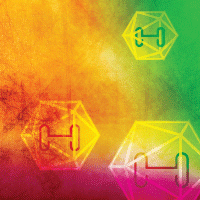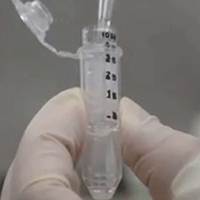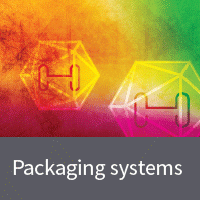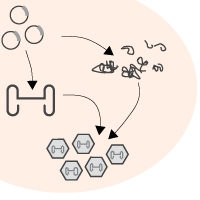Frequently asked questions about AAV delivery
General questions
What are the main features of adeno-associated viruses?
Adeno-associated virus (AAV) is a nonenveloped virus that belongs to the Parvovirus family of the Dependovirus genus. AAV is not thought to be pathogenic to humans and only replicates in the presence of a helper virus, such as adenovirus or herpesvirus. The capsid structural proteins determine the ability of the virus to infect tissues/cells; tissue-specificity is known to differ for various serotypes.
What features of AAV makes the virus a good vector for gene delivery?
AAV vectors exploit the properties of AAV for transduction of genes to cells and organisms. AAV vectors are generally considered safer than adenoviral and retroviral vectors. AAV vectors can be used to transduce genes into both proliferating and nonproliferating cells and can impart long-term expression in nondividing cells. In addition, AAV has little immunogenicity and is suitable for the transduction of genes into animals (as an in vivo transduction tool).
What are the features of different AAV serotypes?
Serotype is classified by the type of capsid structural proteins and determines tissue specificity. Serotype 2 (AAV2) is the most well-studied serotype. AAV2 has a broad range of tissue infectivity and is the most popular serotype for research purposes. Serotype 5 (AAV5) and serotype 6 (AAV6) have more specific tissue infectivity; AAV5 can infect cells in tissues including the central nervous system, liver, and retina, whereas AAV6 can infect cells in tissues including heart, muscle, and liver.
We currently offer products for production, purification, and titration of AAV2 for gene delivery.
What precautions should be taken when working with recombinant AAV?
It is imperative to fully understand the potential hazards of and necessary precautions for the laboratory use of AAV vectors. Viruses could, depending on your gene insert, be potentially hazardous. Similar vectors have been approved for human gene therapy trials, attesting to their potential ability to express genes in vivo. For these reasons, due caution must be exercised in the production and handling of any recombinant viruses.
Follow all applicable guidelines for research involving recombinant DNA. Take appropriate safety measures when producing or handling recombinant AAV, including working in a biological safety cabinet and wearing protective laboratory coats, face protection, and gloves.
Are there published examples of AAV2 being used for in vivo gene transfer?
AAV2 particles generated using the AAVpro series were successfully used for in vivo delivery of a bright fluorescent marker to cells in a very specific brain region in mouse.
In addition, AAV2 was used for gene delivery in the following studies (none of these examples use AAVpro products).
| Target tissue | Description | Citation |
|---|---|---|
| Brain | AAV2 used to deliver Cre to the subventricular zone | Lee N., et al. Ciliary neurotrophic factor receptor regulation of adult forebrain neurogenesis. J. Neurosci. 33, 1241–1258 (2013). |
| Brain | AAV2 was used for gene delivery directly to the hippocampus | Passini MA, et al. AAV vector-mediated correction of brain pathology in a mouse model of Niemann-Pick A disease. Mol. Ther. 11, 754–762 (2005). |
| Liver | AAV2 carrying a gene under the control of a liver-specific promoter was intravenously administered to mice | Ziegler RJ, et al. AAV2 Vector Harboring a Liver-Restricted Promoter Facilitates Sustained Expression of Therapeutic Levels of a-Galactosidase A and the Induction of Immune Tolerance in Fabry Mice. Mol. Ther.9, 231–240 (2004). |
| Pancreas | AAV2 was used for gene delivery to mouse pancreas | Wang AY, et al. Comparison of adenoviral and adeno-associated viral vectors for pancreatic gene delivery in vivo. Hum Gene Ther. 15, 405–413 (2004). |
How much AAV should be used for general animal experiments?
The amount used depends on the target tissue and method of administration, but for mice the amount will be between 1011 and 1012 vg/animal (vg = vector genome, as measured by real-time PCR). However, the exact dose should be determined empirically.
Recombinant AAV production questions
What is “helper-free” production?
In general, replication of AAV requires a helper virus such as adenovirus or herpesvirus. Our AAV helper-free vector systems generate recombinant AAV without the use of a helper virus ("helper-free"). Instead, packaging is accomplished by transfecting HEK 293 cells (e.g. AAVpro 293T Cell Line) with plasmids that encode the factors necessary to prepare recombinant AAV particles.

"helper-free" production
What cells are suitable for the production of AAV particles?
For the AAVpro Helper Free Systems, use HEK 293T or HEK 293 cells.
Several HEK 293 and HEK 293T cell lines are commercially available. Viral production is highly dependent on features of the cell line. The AAVpro 293T Cell Line* or HEK 293T/17 cells (ATCC, CRL-11268) are recommended for preparation of high-titer AAV.
*The AAVpro 293T Cell Line is a subclone of the transformed human embryonic kidney cell line HEK 293, which is highly transfectable and supports high levels of viral protein expression. The cell line also constitutively expresses the simian virus 40 (SV40) large T antigen. When combined with the AAVpro Helper Free System, these cells can produce high titers of recombinant adeno-associated virus (AAV).

Infection of cultured cells cannot be confirmed; what could be the cause?
It is possible that high titers of AAV were not produced. Consider the following possible causes:
- The HEK 293 cell line used may affect AAV production. We recommend using the AAVpro 293T Cell Line or HEK 293T/17 (ATCC CRL 11268) cells. We have confirmed efficient AAV production for these cell lines.
- It is possible that transfection efficiency is low. Be sure to follow the transfection methods outlined in the user manual.
Do you offer control vectors?
What are the advantages of the AAVpro Helper Free System in comparison with AAV production kits from other companies?
Our kits includes a vector that expresses hsa-miR342, a human microRNA that increases AAV production. This system increases titer by ~2-fold compared with the pRC2 vector alone.

Amount of AAV particles prepared with the AAVpro Helper Free System (AAV2) is in the range of 1010 and 1011 vg/10 cm dish (vg = vector genome, as measured by real-time PCR). Please note the amount of AAV particles produced is dependent on culture conditions and target genes.
AAV purification questions
I want to purify my AAV vector. Which kit do you recommend?
We recommend the AAVpro Purification Kit (All Serotypes) as this kit can be used for any AAV serotype. View the tech notes »
What are the benefits of using the AAVpro Purification Kit (All Serotypes)?
Ultracentrifugation is commonly used for AAV purification. However, this method requires a high skill level and several days (2–3) to complete. The AAVpro Purification Kit (All Serotypes) provides a simple and fast (~4 hours) method for AAV particle purification of any serotype from virus-producing cells.

Summary of the AAV particle purification protocol using the AAVpro Purification Kit Maxi (All Serotypes).
Purified AAV can be used for in vivo studies. Watch the video protocol »
What number of cells can be used for AAV purification with the AAVpro Purification Kit (All Serotypes)?
The AAVpro Purification Kit (All Serotypes) enables purification of AAV particles from cells grown in up to five T225 cell culture flasks. Please see the table below.
| Product | Cat. # | Serotype(s) | Size | # of flasks or dishes per purification |
|---|---|---|---|---|
| AAVpro Purification Kit Midi (All Serotypes) | 6675 | All | 4 purifications |
|
| AAVpro Purification Kit Maxi (All Serotypes) | 6666 | All | 4 purifications |
|
For administration to animals, how should AAV particles be purified?
There are no definitive purity criteria for in vivo transduction. You can confirm AAV purity by SDS-PAGE analysis; there should only be three major bands (corresponding to AAV VP1, VP2, and VP3).
AAV particles purified using the AAVpro Purification Kit (All Serotypes) have been used successfully for in vivo transduction in several animal species. View the tech notes »

Viral particles from serotypes AAV1, AAV2, AAV3, AAV5, and AAV6, each carrying the fluorescent protein ZsGreen1, were purified from producer cells cultured in five T225 flasks using the AAVpro Purification Kit Maxi (All Serotypes). SDS-PAGE was performed on each sample, with 1 x 109 vector genomes loaded per lane. Three bands corresponding to AAV VP1, VP2, and VP3 are present for each serotype sample.
What is standard yield of AAV particles using the AAVpro Purification Kit (All Serotypes)?
Standard yields using the AAVpro Purification Kit (All Serotypes) are shown in the table below.
| Product | Cat. # | Standard yield range per prep (real-time PCR) | |
|---|---|---|---|
| Yields after extraction | Yields after purification | ||
| AAVpro Purification Kit Midi (All Serotypes) | 6675 | 4 x 1010 – 2 x 1012 vg/prep | 1 x 1010 – 5 x 1011 vg/prep |
| AAVpro Purification Kit Maxi (All Serotypes) | 6666 | 2 x 1011 – 1 x 1013 vg/prep | 5 x 1010 – 2.5 x 1012 vg/prep |
vg = viral genome
AAV titration questions
Which serotypes can be measured with the AAVpro Titration Kit (for Real Time PCR) Ver.2?
The primers in this kit are specific for the inverted terminal repeat (ITR) region of AAV2. Therefore, if the AAV vector being used includes the ITR region from AAV2, it is possible to measure titer regardless of the serotype.
What are the advantages of the AAVpro kit in comparison to other conventional titration methods?
Conventionally, a region of the inserted sequence is used for quantification of AAV vector. With this method, it is necessary to design primers for each AAV vector. The AAVpro Titration Kit (for Real Time PCR) Ver.2 uses a common region of the AAV vector, the AAV2 inverted terminal repeat (ITR), as a target. If the ITR region of the vector is derived from AAV2 (as is the case for most commonly used constructs), the kit can be used regardless of the serotype.
Learn more about AAVpro Titration Kit (for Real Time PCR) Ver.2 »
AAV extraction questions
Is AAVpro Extraction Solution compatible with any AAV serotype?
It can be used regardless of the serotype. However, for some serotypes lower extraction efficiency is obtained as compared with traditional methods. For AAV5, we have found lower extraction efficiency with AAVpro Extraction Solution as compared with freeze-thaw methods, but the final viral solution had fewer contaminants when AAVpro Extraction Solution was used.
Upon addition of AAV Extraction Solution B, the solution turned pink; is this a problem?
Depending on the sample, the solution may turn pink upon addition of AAV Extraction Solution B, but this color change does not affect extraction efficiency.
Takara Bio USA, Inc.
United States/Canada: +1.800.662.2566 • Asia Pacific: +1.650.919.7300 • Europe: +33.(0)1.3904.6880 • Japan: +81.(0)77.565.6999
FOR RESEARCH USE ONLY. NOT FOR USE IN DIAGNOSTIC PROCEDURES. © 2025 Takara Bio Inc. All Rights Reserved. All trademarks are the property of Takara Bio Inc. or its affiliate(s) in the U.S. and/or other countries or their respective owners. Certain trademarks may not be registered in all jurisdictions. Additional product, intellectual property, and restricted use information is available at takarabio.com.







